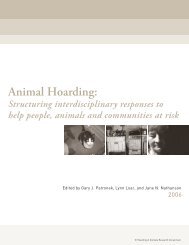TUFTS UNIVERSITY - Cummings School of Veterinary Medicine at ...
TUFTS UNIVERSITY - Cummings School of Veterinary Medicine at ...
TUFTS UNIVERSITY - Cummings School of Veterinary Medicine at ...
You also want an ePaper? Increase the reach of your titles
YUMPU automatically turns print PDFs into web optimized ePapers that Google loves.
Awardee: Stephanie Kozol V’15<br />
Mentor: Dr. Emily McCobb<br />
Award Type: US Army<br />
Research Project: Anesthetic Management and Short‐Term Survival After Splenectomy<br />
Summary: Several studies have shown th<strong>at</strong> when a dog presents with a splenic mass and<br />
hemoabdomen, the dog is likely to have a malignant and possible metast<strong>at</strong>ic neoplasia and therefore a<br />
grave prognosis for survival. Clinicians commonly presume th<strong>at</strong> a case th<strong>at</strong> presents with characteristics<br />
<strong>of</strong> benign splenic lesions will have a good prognosis. Although this may be the case for a percentage <strong>of</strong><br />
individuals, there are other individuals th<strong>at</strong> are similarly presented yet do not survive to discharge and<br />
the overall short‐term survival r<strong>at</strong>e for dogs following splenectomy has not been reported. It is the goal<br />
<strong>of</strong> this overall study to determine the short‐term survival r<strong>at</strong>e for dogs undergoing splenctomy and to<br />
determine wh<strong>at</strong> peri‐oper<strong>at</strong>ive parameters are indic<strong>at</strong>ive <strong>of</strong> survival. Specifically, the student conducting<br />
this study will be evalu<strong>at</strong>ing peri‐oper<strong>at</strong>ive anaesthetic parameters, primarily intra‐oper<strong>at</strong>ive<br />
hypotension as a potential indic<strong>at</strong>or <strong>of</strong> short‐term p<strong>at</strong>ient survival. Four hundred and fifty records <strong>of</strong><br />
p<strong>at</strong>ients th<strong>at</strong> underwent splenectomy <strong>at</strong> the Foster Animal Hospital will be analyzed to retrieve clinical<br />
d<strong>at</strong>a from each individual. The short‐term survival r<strong>at</strong>e for dogs in this popul<strong>at</strong>ion will be determined.<br />
For this‐subproject parameters representing peri‐oper<strong>at</strong>ive p<strong>at</strong>ient management will be analyzed to<br />
determine whether differences were correl<strong>at</strong>ed with the short‐term survival. Results <strong>of</strong> this project<br />
could help clinicians better prepare owners <strong>of</strong> dogs with splenic masses about wh<strong>at</strong> to expect after<br />
surgery.<br />
Awardee: Kendra LaFauci V’15<br />
Mentor: Dr. Elizabeth Rozanski<br />
Award Type: NIH<br />
Research Project: Assessment <strong>of</strong> Pleural Pressure in <strong>Veterinary</strong> <strong>Medicine</strong> Using Pleural<br />
Manometry<br />
Summary: The purpose <strong>of</strong> this experiment is to investig<strong>at</strong>e whether or not pleural manometry can be<br />
used to evalu<strong>at</strong>e the pleural pressure <strong>of</strong> canine and feline p<strong>at</strong>ients in an emergency and critical care<br />
setting. Pleural manometry has been previously performed in human medicine; however, its use in<br />
veterinary medicine has not been documented. Assuming this procedure can be duplic<strong>at</strong>ed in animals,<br />
we also hope to investig<strong>at</strong>e how pressure changes rel<strong>at</strong>e to the volume <strong>of</strong> fluid removed as well as to<br />
24



